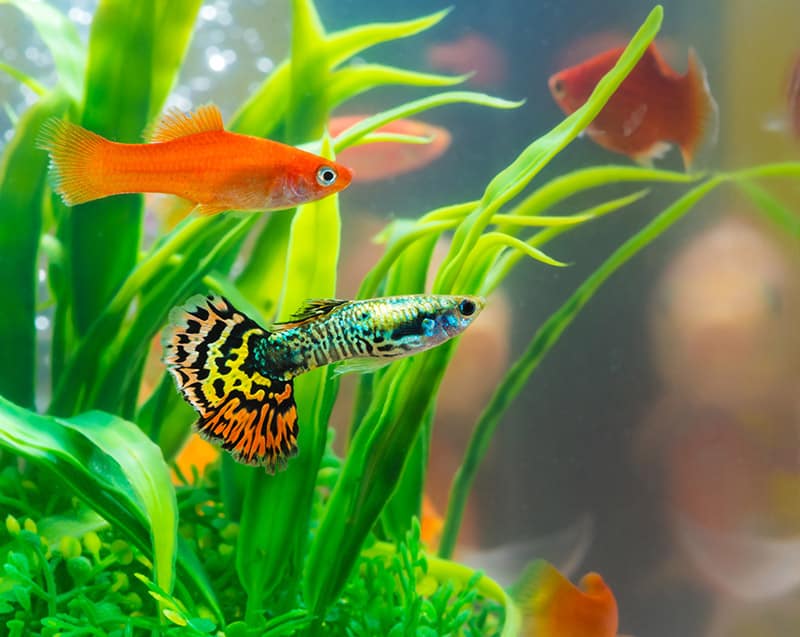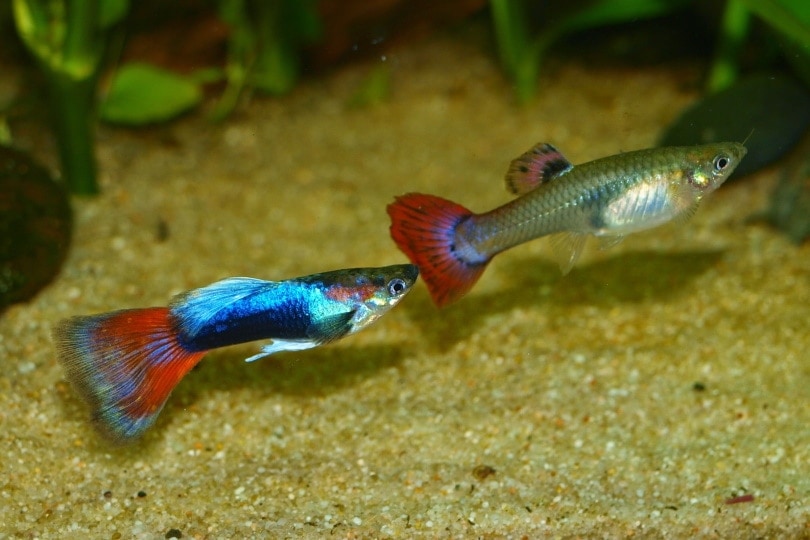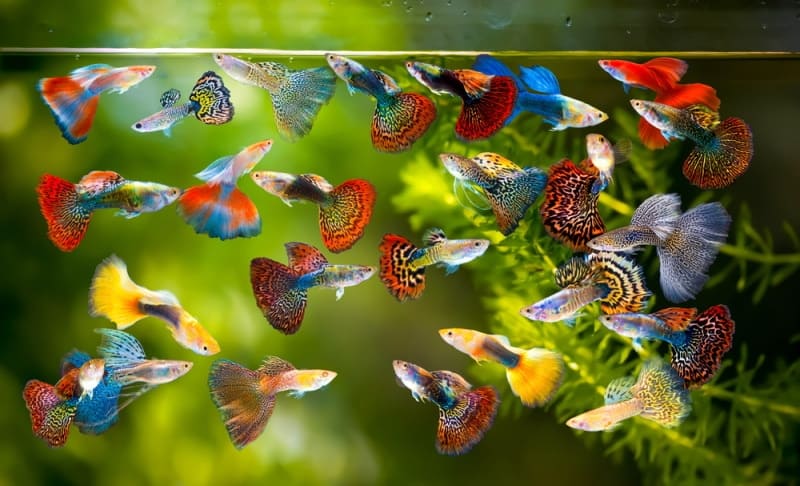Guppies, Poecilia reticulata, also known as Millions Fish, are an all-time favorite of both beginning and experienced fish keepers. Their coloration is as individual as a fingerprint, making each specimen a unique work of art. Fancy varieties are exquisitely colored and sometimes have all the colors of the rainbow. Every Fancy Guppy is a masterpiece, and no two fish are exactly alike!
The Fancy Guppy has been one of the most beloved fish species of the past century. Dedicated breeders have managed, in just a few decades, to take the wild guppy, a mostly gray fish with a few splotches of color, and breed it into strains displaying the most intense and vibrant coloration imaginable. The Guppy packs a load of color for such a small fish! Even the females, who were comparatively drab until recently, are being bred to show stunning tail coloration.
The appeal of the guppy is not only restricted to its gorgeous appearance. The personality of this fish has charmed generations of aquarists. The guppy is neither shy nor aggressive, and its personality is characterized by a wonderful balance of activity and confidence.
Something to be wary of with this species is stock quality. Mass-produced stock of low quality is likely to be disease-ridden. These fish are, unfortunately, rather prone to fungal infections, which can easily damage the tissue of the Guppy’s large tail. Another problem related to the stock quality is that some of the fanciest true-breeding strains of guppies will be highly inbred. This leads to genetic weaknesses that can also decrease hardiness and resistance.
| What’s in the name? | ||
|---|---|---|
| Poecilia | means | “many-colored” |
| reticulata | means | “netlike” |
Overall, Guppies are very tolerant of a wide variety of tank conditions, though the highly inbred, specialized species can be more delicate and require more attention. A tank with some plants and 1 to 1.25 teaspoons of aquarium salt per gallon will keep this beautiful little fish happy and healthy. They are capable of adapting to brackish or saltwater conditions.
This fish is probably the most widely available species of tropical fish. As the common name Millions Fish suggests, this species breeds readily and frequently. The aquarist that chooses to keep fish of both sexes will soon have a tank with multiple generations of Guppy.
- For Information on keeping freshwater fish, see: Freshwater Aquarium Guide: Aquarium Setup and Care
Guppies – Millions Fish
Scientific Classification
| Kingdom: | Animalia |
| Phylum: | Chordata |
| Class: | Actinopterygii |
| Order: | Cyprinodontiformes |
| Family: | Poeciliidae |
| Genus: | Poecilia |
| Species: | reticulata |
Fancy Guppies – Quick Aquarium Care
| Aquarist Experience Level: | Beginner |
| Aquarium Hardiness: | Very hardy |
| Minimum Tank Size: | 5 gal (19 L) |
| Size of fish – inches | 2.4 inches (5.99 cm) |
| Temperament: | Peaceful |
| Temperature: | 68.0 to 82.0° F (20.0 to 27.8° C) |
Habitat: Distribution / Background
The Guppy, Poecilia reticulata, was first described by Wilhem Peters in 1859. They are widely distributed in Southern and Central America, specifically Venezuela, Barbados, Trinidad, Brazil and the Guyanas. They have also been introduced widely within the Americas and Australia, mostly for mosquito control. They are not endangered, and the Guppy is not listed on the IUCN Red List of Threatened Species.
Specimens collected by the botanist Dr. Robert Guppy in 1866 were brought to Europe, and they were subsequently determined to be a new species by the British Museum. The species was named after Dr. Guppy. Other common names they are known by are Millions Fish, Million Fish, Fancy Guppy, Ornamental Guppy, Rainbow Fish, and Fancy Millions Fish Guppy.
There is a great deal of color diversity within the species, and it breeds readily and quickly. These characteristics have made it possible for breeders to create an incredible variety of strains with all kinds of color combinations and patterns. There is also a diverse range of variations in the tail fin, including Sword and Double Sword varieties, Roundtail, Pintail, Flagtail, and the ever popular Fantail variety.
In the wild, Guppies are found in a wide range of water bodies including canals, ditches, warm springs, turbid ponds, and mountain streams. They occur in a wide variety of habitats, but are usually found in waters that are quiet and densely vegetated. They can tolerate a wide salinity range and water temperatures ranging from 64-82° F (18-28° C). These fish often live in shoals in the wild, depending on the amount of predation.They feed on detritus with algae and plant matter and also consume zooplankton, diatoms, invertebrates, small insects, and insect larvae.
- Scientific Name: Poecilia reticulata
- Social Grouping: Groups – Though not a schooling fish, they will often shoal in the wild, depending on the amount of predation.
- IUCN Red List: NE – Not Evaluated or not listed
Description
The Guppy is a small fish with an elongated body. Along with the Mollies, Swordtails, and Platy fish, it is a member of the Poeciliidae family of Live-bearing Toothcarps, which are distinguished by having teeth in both their upper and lower jaws. Females are larger, reaching between 1.2 to 2.4 inches (3-6 cm) in length while the males reach between .6 to 1.4 inches (3-6 cm). Fancy Guppies produced in captivity can get a bit larger than their wild relatives.
Their lifespan in the wild is quite variable but averages about 2 years. A well cared for aquarium guppy lives 1 1/2 to 3 years on average. They have a shorter lifespan if kept in warmer water, which speeds their metabolism.
Guppy males are small and slender and exhibit all sorts of colors. The larger, thicker females are a lead gray color. Males usually have a larger and more colorful tail fin than females as well. As the male fish matures, the middle rays of its anal fin become modified into a narrow copulatory organ called a gonopodium.
Fancy Guppy organizations breed and show guppies all over the world. Selectively bred Guppies come in all colors and combinations of colors. Indeed, they come in every color of the rainbow, and often have every color of the rainbow in them!
Colors play an important role in selective breeding. These fish start with a ground color (main upper body color) that is marked with a “cover” (primarily on the lower body) of bright iridescent colorings and patterns.
There are 4 basic ground colors (wild-color, albino, blond, and blue) as well as a number of other ground colors developed with combinations of those four. The cover can be any imaginable color or combination of colors and have a variety of different names. Some pattern examples are snakeskin (rosette, chain-link pattern), carpet, cobra (rosette pattern with vertical bars), and black (called “tux” or “half-blacks”).
Selectively bred Guppies also have a large variety of tail fins. There are 12 different standard shapes recognized by breeders of Fancy Guppies, including round-tail, pintail, pointed or spear-tail, swordtail (double sword, top sword, and bottom sword), lyretail, spadetail, flagtail, veiltail, fantail, and triangletail or delta. Guppies are named by the color of the tail, so if a Guppy has a yellow body but a red tail, it will be called a red guppy.
- Size of fish – inches: 2.4 inches (5.99 cm) – Females are about twice the size of the males. Although the common length is only about 1.1″ (2.8 cm), captive guppies can grow larger.
- Lifespan: 2 years – On average these fish will live about 2 years, both in the wild and in captivity, but well cared for captive specimens can live even longer, up to about 3 years.
Fish Keeping Difficulty
The Guppy is remarkably easy to care for and breed. It is generally very hardy and undemanding, making it a perfect choice for the beginning aquarist. Less demanding of water quality than most other fish and having a wide tolerance for water temperature, it is rarely ill.
Make sure you select only healthy fish and provide a good tank and varied diet to offset any potential problems. This fish is readily available; however, there is a great disparity in the quality of stock. The extensive finnage of this species also makes it susceptible to damage which can result in infection.
- Aquarium Hardiness: Very Hardy – Guppies are very durable, but there is a disparity in the quality of available stock. Additionally, their extensive finnage is susceptible to damage and resulting infection.
- Aquarist Experience Level: Beginner

Foods and Feeding
Since they are omnivorous, the Guppy will generally eat all kinds of fresh, frozen, and flake foods. In the wild, their diet consists of detritus with algae and plant matter, zooplankton, diatoms, invertebrates, small insects, and insect larvae.
In the aquarium, they will gladly eat most commercially-prepared fish foods as well as supplementary live and vegetable-based food. Feed brine shrimp (either live or frozen) or blood worms as a treat. Baby brine shrimp are a favorite of this species. This fish is not a picky eater but should be fed a varied diet several times daily in very small amounts.
- Diet Type: Omnivore
- Flake Food: Yes
- Tablet / Pellet: Yes
- Live foods (fishes, shrimps, worms): Some of Diet
- Vegetable Food: Some of Diet
- Meaty Food: Some of Diet
- Feeding Frequency: Several feedings per day – Feed small amounts several times a day. Portion size should be what the fish can consume in about 3 minutes.
Aquarium Care
Fancy Guppies do not require special aquarium care and are not too demanding about their tank. Still, the tank should have regular water changes of 25% two to three times a month, depending how many fish it holds and the condition of the water.
As in caring for most of this family, aquarists should add 1-1.25 teaspoons of aquarium salt per gallon. When changing water, replace salted water with salted water, but when replacing water that has evaporated, do not add additional salt. Water that evaporates will leave salts behind, so there is no need to add more salt if you are topping off evaporated water.
- Water Changes: Bi-weekly – Do water changes of 25% every 2-3 weeks, or more often for heavily stocked tanks.
Aquarium Setup
The small but active guppy requires little to be happy. A 5 gallon tank is large enough to keep a trio of guppies. Generally, the sexes are mixed, however, so the aquarist should plan for frequent breeding with a potential for lots of resulting offspring. A 10 to 20 gallon tank may soon be needed. Females should out-populate males slightly to reduce competitive squabbles between males.
These fish will appreciate an aquarium with fine gravel that is heavily planted, along with some floating ferns. This type of vegetation will provide a bit of food for them as well as hiding places for the fry until they are large enough to not be eaten. Any lighting, dim to bright, is fine, but excessive light from above will tend to wash out their coloration.
Most Guppies are very tolerant of a wide variety of tank conditions, though the highly inbred specialized species can be delicate and require more attention. Although they are very tolerant of water conditions, good filtration is helpful in maintaining stable water. Filtration systems remove much of the detritus, excess foods, and waste. This, in turn, helps to keep the tank clean and maintain the general health of the fish.
- Minimum Tank Size: 5 gal (19 L) – A trio can be kept in a 5 gallon (18 Liters) tank, but keeping mixed sexes will result in breeding and quickly increase the population, necessitating a larger tank.
- Suitable for Nano Tank: Yes
- Substrate Type: Small Gravel
- Lighting Needs: Moderate – normal lighting – This fish tolerates low to high lighting, although excessively high lighting from above tends to wash out their coloration.
- Temperature: 68.0 to 82.0° F (20.0 to 27.8° C)
- Range ph: 6.8-8.5
- Hardness Range: 10 – 28 dGH
- Brackish: No – This is not a brackish water fish, but it does appreciate a little salt in the water–about 1-1.25 teaspoons per gallon of water.
- Water Movement: Weak – Water movement should be weak to moderate.
- Water Region: All – The Guppy swims in all levels of the aquarium.
Social Behaviors
The Guppy is extremely active but also very friendly. This fish has a very kind and even temperament and is generally peaceful and active.This sociable fish combines well with all other good-natured fish. Small fishes such as armored catfish (Corydoras), Platy fish, Tetras and other Characins make good tankmates.
These active fish form loose schools and are always on the move. Though they are peaceful community fish and easily kept with other livebearers, they may chase fry and will often nip the fins of the Betta or Siamese Fighting Fish. The aquarist should avoid combining the Guppy with the Betta, particularly in small quarters, as one of the two or both are bound to get their fins shredded.
- Venomous: No
- Temperament: Peaceful – This is an excellent community fish and mixes well with most other small, peaceful fish. The exception to this is the Betta fish, which will either suffer fin nipping by the guppy or mistake guppies for another Betta and attack. In either case, this combination does not usually end well.
- Compatible with:
- Same species – conspecifics: Yes – They are tolerant of juveniles, but they will chase and eat newborn fry.
- Peaceful fish (): Safe
- Semi-Aggressive (): Monitor
- Aggressive (): Threat
- Large Semi-Aggressive (): Threat
- Large Aggressive, Predatory (): Threat
- Safe
- Shrimps, Crabs, Snails: Safe – not aggressive
- Plants: Safe
Sexual differences
The female guppy is both longer and stockier than the male, and tends to have less rich coloration. Females may also have a spawning patch, a small dark blotch at the base of the caudal fin, at breeding time. The male Guppy is smaller and slender and will generally have a longer, more colorful tail fin. The male also has a gonopodium, a modification of the anal fin into a rod shape which is used in the reproductive process.

Breeding / Reproduction
This livebearing fish breeds readily in the home aquarium without special attention if well fed and cared for. Little more is required than to introduce both sexes into the aquarium. The young reach sexual maturity at a very young age. Males mature in 7 weeks or less and females at 3 months.
To selectively breed guppies, you will want to have one male with two or three females. Provide a breeding tank that is 10 to 20 gallons in size with gentle filtration. You will notice the female is pregnant when she develops a gravid spot, a dark mark on her abdomen. The gestation period is about 26 to 31 days.
Monitor the fish closely when she is close to giving live birth. Guppies will chase their fry and may eat them if given a chance. The young will be consumed unless they are removed, isolated as with a breeding trap for example, or simply given enough hiding spaces such as dense rooted or floating plants. The broods can be up to 100 fry, and the female can produce young again in about four to eight weeks. For more information, see the guide for breeding Livebearing Fish: Breeding Freshwater Fish – Livebearers.
- Ease of Breeding: Easy
Fish Diseases
Guppies are relatively hardy and do not have any particular weakness for certain diseases, though their extensive fins can fall victim to fungal infections. Still, they are subject to the same diseases as other tropical fish. One of the most common freshwater fish ailments is ich. The best way to proactively prevent disease is to give them the proper environment and a well-balanced diet. The more closely their environment mimics their natural habitat, the less stress the fish will have, making them healthier and happier. A stressed fish is more likely to acquire disease.
Anything you add to your tank can introduce disease. Not only other fish, but plants, substrate, and decorations can harbor bacteria. Take great care and make sure to properly clean or quarantine anything that you add to an established tank so as not to upset the balance. For information about fish diseases and illnesses, see Aquarium Fish Diseases and Treatments.
Availability
The Guppy is among the most commonly available fish in the world, usually at a very modest price.
Featured Image Credit: panpilai paipa, Shutterstock
